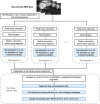Empirical evaluation of human fetal fMRI preprocessing steps
- PMID: 36204420
- PMCID: PMC9531599
- DOI: 10.1162/netn_a_00254
Empirical evaluation of human fetal fMRI preprocessing steps
Abstract
Increased study and methodological innovation have led to growth in the field of fetal brain fMRI. An important gap yet to be addressed is optimization of fetal fMRI preprocessing. Rapid developmental changes, imaged within the maternal compartment using an abdominal coil, introduce novel constraints that challenge established methods used in adult fMRI. This study evaluates the impact of (1) normalization to a group mean-age template versus normalization to an age-matched template; (2) independent components analysis (ICA) denoising at two criterion thresholds; and (3) smoothing using three kernel sizes. Data were collected from 121 fetuses (25-39 weeks, 43.8% female). Results indicate that the mean age template is superior in older fetuses, but less optimal in younger fetuses. ICA denoising at a more stringent threshold is superior to less stringent denoising. A larger smoothing kernel can enhance cross-hemisphere functional connectivity. Overall, this study provides improved understanding of the impact of specific steps on fetal image quality. Findings can be used to inform a common set of best practices for fetal fMRI preprocessing.
Keywords: Denoising; Fetal fMRI; Functional connectivity; Normalization; Preprocessing; Smoothing.
© 2022 Massachusetts Institute of Technology.
Figures











References
Grants and funding
LinkOut - more resources
Full Text Sources
Miscellaneous
